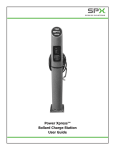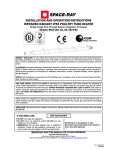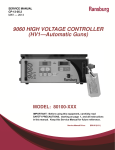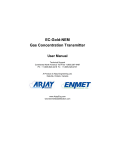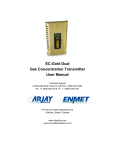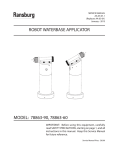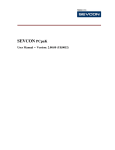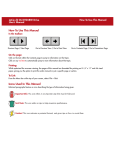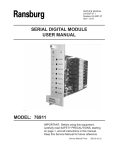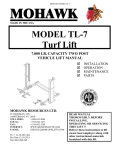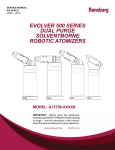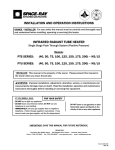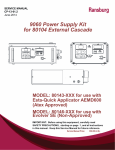Download Test Stand (Serv. Man. LN-9259-07)
Transcript
SERVICE MANUAL LN-9259-07.1 Replaces LN-9259-07 April - 2013 RMA-303 INDIRECT / RMA-303 DIRECT EVOLVER 303 / EVOLVER NE TEST STATIONS CAT DESC MANUFACTURER 160 CAT 160 TURBINE S.A.O./FAN BEARING AIR S.A.I./ATOM CAT DESC MANUFACTURER DESC MANUFACTURER 100 100 100 100 100 IMPORTANT: Before using this equipment, carefully read SAFETY PRECAUTIONS, starting on page 1, and all instructions in this manual. Keep this Service Manual for future reference. Service Manual Price: $30.00 (U.S.) LN-9259-07.1 Test Stations - Contents CONTENTS PAGE SAFETY: 1-4 SAFETY PRECAUTIONS............................................................................................................ 1-2 HAZARDS / SAFEGUARDS....................................................................................................... 3-4 INTRODUCTION: 5-8 GENERAL INFORMATION......................................................................................................... 5 SPECIFICATIONS....................................................................................................................... 5 FEATURES.................................................................................................................................. 6-7 OPERATION: 9-20 RMA TEST PROCEDURE.......................................................................................................... INITIAL TEST SETTIN GS............................................................................................................ TEST TRIGGERS........................................................................................................................ TURBINE TEST......................................................................................................................... .. 9 9-10 11-14 15-16 16-17 17-19 MAINTENANCE: 21-22 MAINTENAN 21 WARRANTY POLICIES: 23 LIMITED WARRANTY................................................................................................................. 23 LN-9259-07.1 Test Stations - Safety SAFETY SAFETY PRECAUTIONS Before operating, maintaining or servicing any Ransburg electrostatic coating system, read and understand all of the technical and safety literature for your Ransburg products. This manual contains information that is important for you to know and understand. This information relates to USER SAFETY and PREVENTING EQUIPMENT PROBLEMS. To help you recognize this information, we use the following symbols. Please pay particular attention to these sections. A WARNING! states information to alert you to a situation that might cause serious injury if instructions are not followed. A CAUTION! states information that tells how to prevent damage to equipment or how to avoid a situation that might cause minor injury. A NOTE is information relevant to the procedure in progress. While this manual lists standard specifications and service procedures, some minor deviations may be found between this literature and your equipment. Differences in local codes and plant requirements, material delivery requirements, etc., make such variations inevitable. Compare this manual with your system installation drawings and appropriate Ransburg equipment manuals to reconcile such differences. WARNING > The user MUST read and be familiar with the Safety Section in this manual and the Ransburg safety literature therein identified. > This manual MUST be read and thoroughly understood by ALL personnel who operate, clean or maintain this equipment! Special care should be taken to ensure that the WARNINGS and safety requirements for operating and servicing the equipment are followed. The user should be aware of and adhere to ALL local building and fire codes and ordinances as well as NFPA-33 SAFETY STANDARD, prior to installing, operating, and/or servicing this equipment. WARNING > The hazards shown on the following page may occur during the normal use of this equipment. Please read the hazard chart beginning on page 3. Careful study and continued use of this manual will provide a better understanding of the equipment and process, resulting in more efficient operation, longer trouble-free service and faster, easier troubleshooting. If you do not have the manuals and safety literature for your Ransburg system, contact your local Ransburg representative or Ransburg. 1 LN-9259-07.1 Test Stations - Safety NOTE NOTES > The high voltage is interlocked electrically with the fluid trigger switches. When a fluid switch is triggered on, the HV will automatically be turned off. WARNING > Wear the proper safety protection such as eye and ear protection. > NEVER wear loose clothing while working around the applicator. > NEVER run the applicator with anyone near the bell. Serious injury COULD OCCUR if the bell is contacted while it is rotating. > NEVER stop the rotation of the bell by hand. Use the manual air brake supplied on the test stand panel. > Ensure ALL items in the test area are grounded. Ensure there are NO open containers of flammable materials in the test area. LN-9259-07.1 2 Test Stations - Safety AREA Tells where hazards may occur. Spray Area HAZARD Tells what the hazard is. Fire Hazard Improper or inadequate operation and maintenance procedures will cause a fire hazard. Protection against inadvertent arcing that is capable of causing fire or explosion is lost if any safey interlocks are disabled during operation. Frequent power supply shutdown indicates a problem SAFEGUARDS Tells how to avoid the hazard. Fire extinguishing equipment must be present in the spray area and tested periodically. Spray areas must be kept clean to prevent the accumulation of combustible residues. Smoking must never be allowed in the spray area. The high voltage supplied to the atomizer must be turned off prior to cleaning, flushing, or maintenance. When using solvents for cleaning: Those used for equipment flushing should have flash points equal to or higher than those of the coating material. Those used for general cleaning must have flash points above 100°F (37.8°C). Spray booth ventilation must be kept at the rates required by NFPA 33, OSHA, and local codes. In addition, ventilation must be maintained during cleaning operations using flammable or combustible solvents. Electrostatic arcing must be prevented. Test only in areas free of combustible material. Testing may require high voltage to be on, but only as instructed. Non-factory replacement parts or unauthorized equipment modifications may cause fire or injury. If used, the key switch bypass is intended for use only during setup operations. Production should never be done with safety interlocks disabled. Never use equipment intended for use in waterborne installations to spray solvent based materials. The paint process and equipment should be set up and operated in accordance with NFPA-33, NEC, and OSHA requirements. 3 LN-9259-07.1 Test Stations - Safety AREA Tells where hazards may occur. General Use and Maintenance HAZARD Tells what the hazard is. SAFEGUARDS Tells how to avoid the hazard. Improper operation or mainte- Personnel must be given training in accordance with the requirements of NFPA-33. nance may create a hazard. Personnel must be properly Instructions and safety precautions must be read trained in the use of this equip- and understood prior to using this equipment. ment. Comply with appropriate local, state, and national codes governing ventilation, fire protection, operation maintenance, and housekeeping. Reference OSHA, NFPA-33, and your insurance company requirements. Electrical Equipment High voltage equipment is utilized. Arcing in areas of flammable or combustible materials may occur. Personnel are exposed to high voltage during operation and maintenance. The power supply, optional remote control cabinet, and all other electrical equipment must be located outside Class I or II, Division 1 and 2 hazardous areas (refer to NFPA-33). Turn the power supply OFF before working on the equipment. Protection against inadvertent arcing that may cause a fire Test only in areas free of flammable or combustible or explosion is lost if safety material. circuits are disabled during Testing may require high voltage to be on, but operation. only as instructed. Frequent power supply shutdown indicates a problem in Production should never be done with the safety the system which requires circuits disabled. correction. Before turning the high voltage on, make sure no An electrical arc can ignite objects are within the sparking distance. coating materials and cause a fire or explosion. LN-9259-07.1 4 Test Stations - Introduction INTRODUCTION GENERAL INFORMATION specifications The Ransburg Applicator Performance Test Stand was developed to assist in determining the applicator’s level of performance in an off-line condition. (Ensuring the applicator functions properly after any maintenance has been performed to it and reduces the costs associated with verifying performance during production.) With line speeds critical to the through-put of a facility, every uptime minute counts to underwrite profitability. This Test Stand device helps to ensure the applicator performs correctly when it is put into service. Electrical / Physical This Test Stand will verify performance of single or dual fluid applicators, bearing air, shaping air, brake air, turbine drive air, and fiber optic functionality. As well, it checks kV and µA electrical performance of the applicator. 1-inch NPT(F) Inlet Air Requirements: 3/4-inch ID Air Line to Stand 100 psi (6.4 bar) minimum 30 SCFM 0.3 to 0.6 Micron Filtration Dimensions Height: 67-inch (1702cm) Width: 30-inch (762cm) Length: 48-inch (1219cm) Fluids: Use distilled or deionized water only for testing. Maximum Fluid Pressure: 80 psi (5.2 bar) The Test Stand was developed with the user and the safety of the user in mind. The user must become familiar with the overall function and operation of the unit. NOTE > For all test station toggle switches, with the switch lever in the “UP” position, the valve it describes is “ON” or “actuated.” 5 LN-9259-07.1 Test Stations - Introduction FEATURES CAT DE SC MANUF ACTURER 160 160 TURBINE S.A.O./FAN BEARING AIR S.A.I./ATOM CAT DE SC MANUF ACTURER 100 100 100 100 100 1 Main Control Panel 5 Pressure Pot 2 Air Flow Meters 6 Dump Bucket 3 Test Applicator 7 High Voltage Cascade 4 Table 8 Air Filter Figure 1a: Basic Station Features LN-9259-07.1 6 Test Stations - Introduction CAT DESC MANUF ACTURER 160 160 CAT CAT DESC TURBINE S.A.O./FAN BEARING AIR S.A.I./ATOM DESC MANUF ACTURER MANUF ACTURER 100 100 100 100 100 1 Power Control - On/Off Button 9 2 Main Air Gauges - Leak Down, Supply Air 10 Atomizer Card 3 Fiber Optic Voltage Readout 11 MicroPak Power Supply 4 Air Flow Meter - Atom Air 12 Applicator Enable, Paint Trigger, Cup Wash Solvent, Cup Wash Air, Dump 5 Air Flow Meter - Outer Shaping Air Atomizer Speed Select Card 6 Air Flow Meter - Bearing Air 13 Regulated Function Gauges - Bearing Air, Outer Shaping Air, Inner Shaping Air 7 Air Flow Meter - Inner Shaping Air 14 High Voltage - On/Off Switch 8 Fluid Enable - Paint In, Cup Wash Solvent In, Cup Wash Air In Figure 1b: Basic Station Features 7 LN-9259-07.1 Test Stations - Introduction NOTES LN-9259-07.1 8 Test Stations - Operation OPERATION rma TEST PROCEDURE WARNING > NEVER use solvent as a test fluid for this device! Setup NOTE > Refer to the applicator service manual for all parts and part number identifications. 1. Ensure that ground connections, cart ground, and applicator ground are made to a true earth ground. WARNING > If true earth ground is not made, injury to personnel or serious damage may occur to the equipment. > Ensure ALL items in the test area are grounded. Ensure there are NO open containers of flammable materials in the test area. 2. Provide air filtration to the manifold that has the capability of passing 30 SCFM with particulate removal of .3 to .6 micron particle size (bearing air filtration is provided with the stand). 3. Provide a minimum 3/4-inch ID air line to the filter at the manifold inlet. A minimum of 100 psig pressure is required at the manifold inlet. > Using any material OTHER than distilled water or de-ionized water may cause fire during the test. Use only distilled water or de-ionized to test the applicator. 5. Fill the pressure pot liner with approximately one (1) gallon of either de-ionized or distilled water. 6. Plug the unit into a suitable 110/120V outlet. NOTE > When opening dump valve for any test, hold tubing securely by hand or clamp to prevent whipping. Initial Test Settings 1. High voltage is off unless instructed to turn on. Main power off. 4. Install water supply line and air pressure line to the pressure pot. 9 LN-9259-07.1 Test Stations - Operation 2. Fluid enable off (toggle switch lever in the down position). 7. Adjust bearing air regulator to 90 psig minimum. 100 3. Attach the applicator to the Test Stand bracket with three (3) M10 screws (78268-00). 4. Connect tubing from the Test Stand to the applicator as labeled. 5. Supply 100 psig air pressure to the stand, reference supply air gauge on panel. If required, adjust air input regulator attached to stand. 6. Set speed select to 00. LN-9259-07.1 10 Test Stations - Operation TEST TRIGGERS 1. Ensure fluid supply is OFF. 5. Toggle on the “Dump” switch; air should be escaping from the “Dump Port” of the applicator. Turn off the “Dump” switch. 2. Turn “fluid” switch to AIR. 3. Toggle the “Paint Fluid Enable” switch on (up) to supply air pressure to the applicator. 6. Toggle “Paint Fluid Enable” switch to the off (down) position. 4. Toggle on the “Paint Trigger” switch; air should be escaping from the feed tube. Turn off the “Paint Trigger”. 7. Turn on the “Cup Wash Air” switch, now turn on the “Bell Solvent” trigger, air should be escaping from the feed tube and cup wash spout. Turn off the “Cup Wash Air” trigger and the “Cup Wash Air In” switch. 8. Turn on the “Cup Wash Solvent” switch, air should be escaping from the feed tube and cup wash spout. Turn off the “Cup Wash Solvent” and “Cup Wash Solvent In”. 11 LN-9259-07.1 Test Stations - Operation Air Test 1. Turn the “Fluid” switch to “Air” then “Off” to pressurize the system. 4. Turn the “Fluid Air” regulator to 0 psig. Open the manual relief valve on the pressure pot. Turn all switches off. Ensure “Fluid Enable” switches are all off. 100 2. Observe the leak test gauge. The pressure must not drop more than 2 psi in 10 seconds. 160 3. Open the “Dump” to de-pressurize the system and turn off all of the trigger valves. Switch the “Dump” to “Off” Static Decay / Water Pressure Test The purpose of this test is to verify that each of the valves in the applicator will pass fluid. Also, this test verifies all seals along the fluid passages have been properly installed to prevent any leakage. 1. Ensure all toggle switches are set to the “off” or “down” position. 2. Position the applicator where any water sprayed out of the bell may be collected and properly disposed of. 3. Verify there is no residual pressure in the pressure pot included with the test stand. Turn the regulator dial on the pressure pot counterclockwise until all pressure is released. Pull the bleed-off valve to release any remaining pressure. LN-9259-07.1 12 Test Stations - Operation 5. Close the lid, tighten the lid clamps so that the lid is secure and no air pressure may escape. WARNING > Never use solvent as a test fluid for this device. 6. Turn the “Fluid” switch to “Water” position. 4. Loosen the pressure pot clamps until the lid may be removed from the pot. Fill the pressure pot with de-ionized or distilled water. 7. Turn the “Fluid Air” regulator to the pressure pot to 80 psi. 8. Make sure the dump line is secured in the bucket and the dump valve is in the “Open” position. 9. Turn on “Paint Fluid Enable” and cup wash “Solvent Fluid Enable” in the Fluid Enable section. 13 LN-9259-07.1 Test Stations - Operation 10. Activate the “dump” trigger until the air is completely purged from the manifold. You will see water running from the dump output. Turn the “Dump” switch off which will stop the water flow. Turn “Fluid” switch to “off”. Leak gauge should stay at pressure. 11. Observe the applicator for any possible water leakage, wait 3 minutes. No seepage is allowed. 12. If leak is found, turn the “Fluid” switch to “Air” and activate the dump until all water is evacuated. Turn “Fluid” switch to “Off”. Repair leak and repeat the test. adjusted to 100 psi input pressure. 4. Readjust the shaping air dial to 25 psi. Reference shaping air gauge for the correct pressure reading. 5. Look at the shaping air flow meter. It should be reading 4-7 CFM (outer) and 4-7 CFM (inner). Make sure the flow meter regulator is adjusted to 100 psi input pressure. 6. Turn off the “Shaping Air” dial. 13. If no leak is found, turn the “Fluid” switch to “Air”. Open the dump to purge out the water. 14. When all water has been evacuated, close the dump, turn off all switches and turn the “Fluid” switch to “Off”. TURBINE S.A.O./FAN BEARING AIR S.A.I./ATOM Shaping Air Consumption Test (Inner and Outer) 1. Reduce the turbine speed from 70k to 30k rpm. 2. Turn on the “Shaping Air” dial and adjust the outer shaping air to 60 psi. Reference the shaping air gauge for the correct pressure reading. Ensure no air leak is present between the shaping air cap and shroud. If present, inspect the assembly. 3. Look at the shaping air flow meter. It should be reading 10-13 CFM (outer) and 10-13 CFM (inner). Make sure the flow meter regulator is 100 LN-9259-07.1 100 14 Test Stations - Operation TURBINE TEST 4. Set the atomizer speed select to 30,000 rpm. The purpose of this test is to verify the applicator rotates properly and sprays reasonably well. With de-ionized or distilled water as the test fluid it is difficult to accurately assess the spray performance characteristics. However, it can give a relative indication of how well the bell will spray in production. 5. Toggle “Enable 1” “On” or in the “Up” position on the atomizer speed select card. Then press the “Speed Enter” button. The turbine should now begin spinning. This should be audible. NOTE > Bell cup and shroud must be attached to end of turbine. Bearing Air / Drive Air Test This test is to verify the applicator responds to changes in setpoints in the speed selector. 1. Raise the safety spin guard and lock it in place with the pin. 6. Adjust the speed select to 50,000 rpm. Press the “Speed Enter” button to enter the new speed. An audible difference in speed should be detected. Adjust the speed again to 70,000 rpm and press “Speed Enter” to enter the new speed. 7. Observe the atomizing air gauge. At 70,000 rpm the air consumption should not exceed 17.0 SCFM. Brake Test 1. Re-adjust the turbine speed select card to 70k rpm. 2. Set the atomizer speed card to 1k rpm. (Do not activate this speed until the next step.) 15 2. Adjust the air regulator for bearing air to 90 psig minimum. 3. Using a stop watch to time the brake speed, press the atomizer speed card button and watch the time it takes for the applicator to reach 1k rpm. 3. The turbine shaft must rotate freely with bearing air supplied. 4. Brake time should NOT exceed 14 seconds. LN-9259-07.1 Test Stations - Operation Fiber Optic Transceiver Test 1. While the turbine is spinning observe the “Fiber Optic Transceiver Voltage” display. The voltage must be greater than .75mV. 2. If the voltage is out of range, there are several NOTE > If these are bad, the applicator most likely will not rotate because the atomizer card will shut the air to the turbine off. ! WARNING > DO NOT use your hand or any object to stop bell cup rotation. possible causes. The most likely are: a. Transmitter inside the bell is bad or is positioned incorrectly. (Refer to the RMA-303 service manual for instructions to cor- rect the problem.) b. Transmitter (75911) or cable (SMC-424 XX) is not properly connected or may be broken. 3. On the atomizer speed select card, toggle the “Enable 1” switch “Off” or “Down”. 4. Stop the spinning turbine shaft by pressing the manual brake button on the front panel of the test station. Do not allow the turbine to spin in the reverse direction or it may damage the unit. ! WARNING > During any part of the turbine tests where the applicator bell is rotating, DO NOT come near or in contact with the spinning bell. Because of the bell rotational speed, injury can easily occur. Locate the bell in a posiiton where minimal exposure to anyone passing by may come in contact with the spinning bell. > NEVER use any fluid other than distilled or de-ionized water to test the applicator performance. Using any other material will cause a risk of fire or severe personal injury. LN-9259-07.1 ! CAUTION > DO NOT hold manual brake button in below 5k rpm. HIGH VOLTAGE TEST In-Direct Charge Test (70kV Maximum) 1. Install the high voltage cable to the high voltage ring and cascade as prescribed in the applicator service manual. Ensure all components are properly grounded. 2. Install the ground cable into the HV/GND port of the mounting manifold. 3. Turn on the main power to the MicroPak. NOTE > Ensure all personnel near the field are grounded. Display should be reading 00 on the kV and µA display. 4. Turn on the “kV Enable” switch. kV should be reading what has been set by adjusting the dial. 5. Using the High Voltage Test Probe (76634-00) check the actual voltage from the high voltage ring 16 Test Stations - Operation by placing the High Voltage Test Probe on the high voltage ring probe tips. Test probe display should match the MicroPak display. 1. Verify “Bell/Applicator” switch is in the applicator position. 6. Turn off the power supply to the MicroPak. Direct Charge Test (90kV Maximum) 1. Install the high voltage cable to the applicator and cascade as described in the applicator service manual. Ensure all components are properly grounded. 2. Turn on the main power to the MicroPak. Display should be reading 00 on the kV and µA display. 2. Turn up “Fan Air Control” knob on the panel until there is 50 psi flowing on the fan air/outer shaping air gauge. NOTE 100 > Ensure all personnel near the field are grounded. 3. Turn on the “kV Enable” switch. kV should be reading what has been set by adjusting the dial. 4. Using the High Voltage Test Probe (7663400) check the actual voltage from the applicator by placing the High Voltage Test Probe on the bell cup. Test probe display should match the MicroPak display. 5. Turn off the power supply to the MicroPak. evolver ne test procedure Air Operation 1. Connect the “Test Air Cap” to the spray head. Toggle the “Applicator Trigger” switch on. Bleed Air Test (Volume) NOTE > Ensure that the regulator at the flow meter is set at 100 psi. 17 LN-9259-07.1 Test Stations - Operation 2. Adjust the “Atom Air” control knob on the panel until there is 50 psi flowing on the atom air gauge. Check that the atom air pressure test gauge shows a pressure. NOTE > Always verifty the flow meter regulator is set at 100 psi. 5. Turn off the “Fan and Atom Air” controls. 100 S.A.I./ATOM 6. Remove the test cap from the applicator. Flow Test 1. Turn on the “Water/Air” switch to the “Water“ position. 3. Adjust the “Manual Fan Air” control knob on the panel until there is 50 psi flowing on the fan air gauge. Check that the fan air pressure test gauge shows a pressure. 2. Turn on the pressure pot valve. 3. Turn on the”Paint Fluid Enable” switch. S.A.O./FAN 100 4. Turn on the “Dump Trigger” until there is no air in the line, then turn off. 4. Turn the “Bell/Applicator” switch to “OFF” position. LN-9259-07.1 18 Test Stations - Operation 5. Turn on the “Applicator Trigger”. NOTES 6. Let the water flow freely through the spray head until there is no air in the line. 7. Shut off the paint trigger. 8. Turn off “Pressure Pot” valve. Turn the Water/ Air” switch to the “Air” position. 9. Turn on the “Applicator” switch and the “Dump Trigger” switch until all traces of water are removed from the dump line. 10. Turn off “Paint Air Enable” switch to release air through the applicator. 11. Turn off all switches and remove the applicator. 19 LN-9259-07.1 Test Stations - Operation NOTES LN-9259-07.1 20 Test Stations - Maintenance maintenance If any maintenance is required, consult factory for spare part availability. 21 NOTES LN-9259-07.1 Test Stations - Maintenance NOTES LN-9259-07.1 22 Test Stations - Warranty Policies WARRANTY POLICIES LIMITED WARRANTY Ransburg will replace or repair without charge any part and/or equipment that fails within the specified time (see below) because of faulty workmanship or material, provided that the equipment has been used and maintained in accordance with Ransburg’s written safety and operating instructions, and has been used under normal operating conditions. Normal wear items are excluded. THE USE OF OTHER THAN RANSBURG APPROVED PARTS VOIDS ALL WARRANTIES. SPARE PARTS: One hundred and eighty (180) days from date of purchase, except for rebuilt parts (any part number ending in “R”) for which the warranty period is ninety (90) days. EQUIPMENT: When purchased as a complete unit, (example: guns, power supplies, control units, etc.), is one (1) year from date of purchase. wrapping the applicator in plastic, SHRINK-WRAP, ETC., will void THIS warranty. RANSBURG’S ONLY OBLIGATION UNDER THIS WARRANTY IS TO REPLACE PARTS THAT 23 HAVE FAILED BECAUSE OF FAULTY WORKMANSHIP OR MATERIALS. THERE ARE NO IMPLIED WARRANTIES NOR WARRANTIES OF EITHER MERCHANTABILITY OR FITNESS FOR A PARTICULAR PURPOSE. RANSBURG ASSUMES NO LIABILITY FOR INJURY, DAMAGE TO PROPERTY OR FOR CONSEQUENTIAL DAMAGES FOR LOSS OF GOODWILL OR PRODUCTION OR INCOME, WHICH RESULT FROM USE OR MISUSE OF THE EQUIPMENT BY PURCHASER OR OTHERS. EXCLUSIONS: If, in Ransburg’s opinion the warranty item in question, or other items damaged by this part was improperly installed, operated or maintained, Ransburg will assume no responsibility for repair or replacement of the item or items. The purchaser, therefore will assume all responsibility for any cost of repair or replacement and service related costs if applicable. LN-9259-07.1 LN-9259-07.1 Service Manual Price: $30.00 (U.S.) Manufacturing 1910 North Wayne Street Angola, Indiana 46703-9100 Telephone: 260/665-8800 Fax: 260/665-8516 Technical/Service Assistance Telephone: 800/ 233-3366 Fax: 419/ 470-2071 www.ransburg.com Technical Support Representative will direct you to the appropriate telephone number for ordering Spare Parts. © 2013 Ransburg. All rights reserved. Models and specifications subject to change without notice. Form No. LN-9259-07.1 Litho in U.S.A. 04/13




























